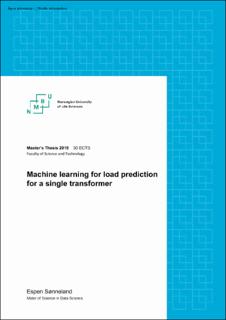| dc.contributor.advisor | Plesser, Hans Ekkehard | |
| dc.contributor.author | Sønneland, Espen | |
| dc.date.accessioned | 2020-02-18T10:21:32Z | |
| dc.date.available | 2020-02-18T10:21:32Z | |
| dc.date.issued | 2019 | |
| dc.identifier.uri | https://hdl.handle.net/11250/2642225 | |
| dc.description.abstract | Statnett is in a process to improve their algorithms for predicting the need for electrical power. In this thesis I tested the possibility of using machine learning to predict the active and reactive load for transformers up to 48 hours ahead in the future, and see how accurate predictions it creates. This was done by using Gradient Boosting Regression, where the model predicts one hour ahead at a time, and then uses the previously predictions to predict even further ahead.
The data used in the model consisted of weather, calendar, and electrical demand data from the time period 2013 – 2018.
The model outperformed the baselines for 1, 24, and 48 hours ahead for predicting active effect. It did not for reactive effect.
The model performs well when the load follows a recurring pattern, but struggles to predict irregularities and sudden magnitude shifts. | en_US |
| dc.language.iso | eng | en_US |
| dc.publisher | Norwegian University of Life Sciences, Ås | en_US |
| dc.rights | Attribution-NonCommercial-NoDerivatives 4.0 Internasjonal | * |
| dc.rights.uri | http://creativecommons.org/licenses/by-nc-nd/4.0/deed.no | * |
| dc.title | Machine learning for load prediction for a single transformer | en_US |
| dc.type | Master thesis | en_US |
| dc.description.version | submittedVersion | en_US |
| dc.source.pagenumber | 32 | en_US |
| dc.description.localcode | M-DV | en_US |

